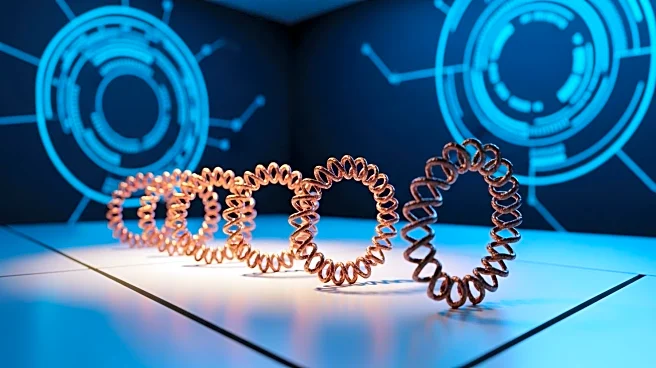What is the story about?
What's Happening?
Researchers from Korea University and Seoul National University have engineered magnetic nanohelices capable of controlling electron spin with high precision at room temperature. This breakthrough, published in Science, utilizes chiral magnetic materials to regulate electron spin without the need for complex circuitry or cooling systems. The nanohelices achieve spin polarization exceeding 80% through their unique geometry and magnetism. The team fabricated these structures by electrochemically controlling metal crystallization, introducing chiral organic molecules to guide the formation of helices with defined handedness. This innovation marks a significant advancement in materials chemistry, enabling spin filtering at room temperature.
Why It's Important?
The development of magnetic nanohelices represents a major step forward in spintronics, a field that promises faster and more energy-efficient data storage and processing devices. By enabling precise control of electron spin direction, this technology could revolutionize computing and information processing. The ability to program handedness in inorganic nanomaterials opens new possibilities for scalable, energy-efficient spintronic devices. This advancement could lead to significant improvements in the performance and efficiency of electronic devices, impacting industries such as computing, telecommunications, and data storage.
What's Next?
The research team plans to explore further applications of chiral spintronics and the architecture of chiral magnetic nanostructures. The ability to control the handedness and number of strands in these nanohelices using electrochemical methods could lead to new application areas. The team aims to develop solid-state devices that leverage chirality-dependent conduction signals, paving the way for practical spintronic applications. Continued research in this area may result in the integration of these technologies into commercial electronic devices, potentially transforming the landscape of modern computing.
Beyond the Headlines
This breakthrough highlights the convergence of geometry, magnetism, and spin transport in scalable inorganic materials. The ability to control chirality in metals and inorganic materials at the nanoscale is a significant achievement, offering new insights into materials chemistry. The research also underscores the importance of interdisciplinary collaboration in advancing technological innovations. The potential for chiral spintronics to impact various fields, including quantum computing and advanced data processing, suggests long-term shifts in technology development and application.
AI Generated Content
Do you find this article useful?













